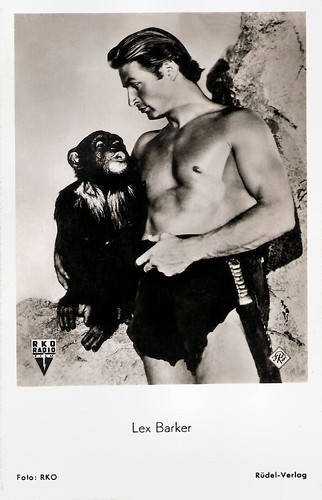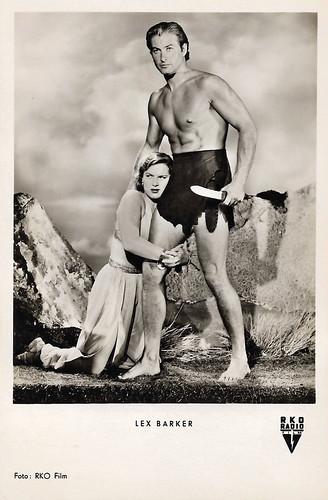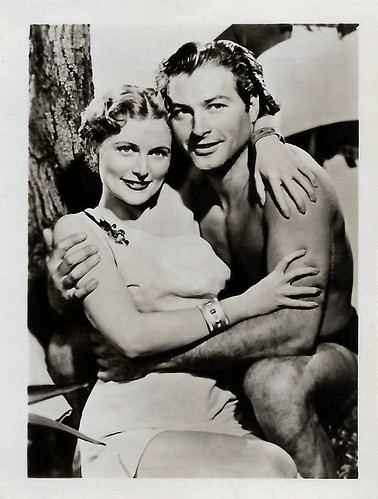
Spanish postcard by JDP, Barcelona, no. 1475. Lex Barker in Tarzan’s magic fountain (Lee Sholem, 1949).

French postcard by Editions P.I., Paris, offered by Les Carbones Korès 'Carboplane', no. 37 G. Photo: H.P.S.
Vintage Dutch postcard. With Pierre Brice at right.
German postcard, no. E 82. Photo: Constantin. Publicity still for Der Schatz im Silbersee/Treasure of Silver Lake (1962).
German postcard by Kruger. Photo: Bernard of Hollywood (Bruno Bernard) / CCC-Produktion. Publicity Still for Old Shatterhand (Hugo Fregonese, 1964).
Disowned by his family
Lex Barker was born Alexander Crichlow Barker, Jr. into a prominent and wealthy New York family in 1919 He was the second child of Alexander Crichlow Barker, Sr., a Canadian-born building contractor and his American wife, the former Marion Thornton Beals. His father later worked as a stockbroker.
Barker took time off from being a high-profile playboy to attend Princeton University but dropped out in order to join a theatrical stock company, much to the chagrin of his family. He made it to Broadway once, in a small role in a short run of William Shakespeare's 'The Merry Wives of Windsor' in 1938. He also had a small role in Orson Welles's disastrous 'Five Kings', which met with so many problems in Boston and Philadelphia that it never made it into New York.
Barker reportedly was spotted by scouts from Twentieth Century Fox and offered a film contract in 1939, but could not convince his parents to sign it (he was underage). Disowned by his family for his choice of an acting career, he worked in a steel mill and studied engineering at night.
In February 1941, ten months before the attack on Pearl Harbor, Barker left his fledgling acting career and enlisted in the US Army. He rose to the rank of major during the war. He was wounded in action fighting in Sicily.
Back in the United States, Barker recuperated at an Arkansas military hospital, then upon his discharge from service, travelled to Los Angeles. Within a short time, he landed a small role in his first film, Doll Face (Lewis Seiler, 1945) starring Vivian Blaine. A string of small roles followed, the best of which was Emmett Dalton in the Western Return of the Bad Men (Ray Enright, 1948). Barker then found the role that would bring him fame.

German postcard by Rüdel-Verlag, Hamburg-Bergedorf, no. 449. Photo: Alex Kahle / RKO Radio Film. Lex Barker in Tarzan's Magic Fountain (Lee Sholem, 1949).

German postcard by Kunst und Bild, Berlin, no. A 580. Photo: RKO. Publicity still for Tarzan And The Slave Girl (Lee Sholem, 1950) with Denise Darcel.

West German collectors card in the Filmstars der Welt series by Greiling-Sammelbilder, series C, no. 103. Photo: RKO. Virginia Huston and Lex Barker in Tarzan’s Peril (Byron Haskin, 1951).

Vintage photo. Lex Barker and Zsa Zsa Gabor in The Girl in the Kremlin (Russell Birdwell, 1957).
Dutch postcard by Facet Publishers, Lunteren, no. 4. Photo: Rank Film Distributors (Holland) N.V. Publicity still from Der Schatz im Silbersee (1963) with Pierre Brice.
Ape-Man
In Tarzan's Magic Fountain (Lee Sholem, 1949), Lex Barker became the tenth official Tarzan of the cinema. He replaced Johnny Weissmuller. His blond, stunningly handsome, and intelligent appearance, as well as his athletic frame, helped make him popular in the role of Edgar Rice Burroughs’ ape-man. Barker made only five Tarzan films produced by Sol Lesser between 1949 and 1953, but he remains one of the actors best known for the role.
His stardom as Tarzan led him to a variety of heroic roles in other films, primarily Westerns, and one interesting (and quite non-heroic) part in a World War II film, Away All Boats (Joseph Pevney, 1956) starring Jeff Chandler. Barker's film career began to stall; the rise of television had erased many roles for the handsome leading man.
In 1957, he moved to Europe. Via England, he made his way to Italy where he was very much at home in the wave of Peplums. He also filmed in Spain and France. In Italy, he had a short but prestigious role as Anita Ekberg's fiancé in Federico Fellini's La Dolce Vita (1960).
But Barker had his greatest success in Germany. There he starred in two films based on the Doctor Mabuse stories (formerly filmed by Fritz Lang). As the hunter of the notorious Dr. Mabuse he played F.B.I. man Joe Como in the two black-and-white crime thrillers Im Stahlnetz des Dr. Mabuse/Return Of Dr. Mabuse (Harald Reinl, 1961) and Die Unsichtbare Krallen des Dr. Mabuse/Invisible Dr. Mabuse (Harald Reinl, 1962).
He also starred in the drama Frauenarzt Dr. Sibelius/Dr. Sibelius (Rudolf Jugert, 1962) and the comedy Frühstück im Doppelbett/Breakfast in Bed (Axel von Ambesser, 1963) with O.W. Fischer. His most successful film was the Karl May adaptation Der Schatz im Silbersee/Treasure of Silver Lake (Harald Reinl, 1962) with Pierre Brice as Winnetou.
German postcard, no. E 79. Photo: Constantin. Publicity still for Der Schatz im Silbersee (1962).
German postcard, no. E 53. Photo: Constantin. Publicity still for Der Schatz im Silbersee (1962).
German postcard, no. E 57. Photo: Constantin. Publicity still for Der Schatz im Silbersee (1962).
Dutch postcard by Gebr. Spanjersberg N.V., Rotterdam / Edition Facet Publishers. Photo: Rank Film Publishers (Holland) N.V. Publicity Still for Der Schatz im Silbersee (1962).
German postcard, no. E 72. Photo: Constantin. Publicity Still for Der Schatz im Silbersee (1962).
James Bond rip-offs
In the following years, Lex Barker played in 12 more films based on novels by Karl May in which he played such well-known May characters as Old Shatterhand, Kara Ben Nemsi, and Dr. Karl Sternau.
While American audiences forgot about him, his popularity in Europe quickly soared above the popularity of stars like John Wayne. In 1966, Barker was awarded the Bambi Award as Best Foreign Actor in Germany. He even recorded a single, in German, with Martin Böttcher, the composer of some of the soundtracks of the Karl May films: Ich bin morgen auf dem Weg zu dir (I'll be on the way to you tomorrow) and Mädchen in Samt und Seide (Girl in Silk and Velvet).
Barker returned to the United States occasionally and made a handful of guest appearances on American television episodes. But Europe, and especially Germany, was his professional home for the remainder of his life.
He showed up in a handful of James Bond rip-offs. In 1967, he appeared with Shirley MacLaine in one part of an American seven-part film Woman Times Seven (1967), directed by Vittorio de Sica.
Lex Barker died of a heart attack in 1973 in New York. He was 54. Barker had been married five times. His wives were Constance Rhodes Thurlow (1942-1950), actress Arlene Dahl (1951-1952), actress Lana Turner (1953-1957), Swiss actress Irene Labhardt (1957-1962) and Carmen Cervera (1965-1972), former Miss Spain. He left behind two sons and one daughter. One of his sons is actor Christopher Barker, from his marriage to Irene Labhart.
German postcard, no. E 66. Photo: Constantin. Publicity still for Der Schatz in Silbersee (1962).
German postcard, no. E 25. Photo: Constantin. Publicity still for Winnetou I (1963) with Mavid Popovic. Caption: "In the water, there is a bitter fight between Old Shatterhand and Winnetou's father, the chief of the Apaches."
German postcard, no. E 68. Photo: Constantin. Publicity still for Der Schatz in Silbersee (1962) with Jan Sid.
German postcard, no. E 64. Photo: Constantin. Publicity still for Der Schatz in Silbersee (1962) with Karin Dor and Pierre Brice.
German postcard, no. E 9. Photo: Constantin. Still from Winnetou - 1. Teil/Apache Gold (Harald Reinl, 1963). Caption: "Old Shatterhand puts a rat in the ammunition and saves himself with a bold leap onto the horse. The remaining car, surrounded by Kiowas, explodes."

German postcard, no. E 28. Photo: Constantin. Lex Barker in Winnetou - 1. Teil/Apache Gold (1963). Caption: The blood brotherhood between Winnetou and Old Shatterhand is sealed with a solemn ceremony.

German postcard, no. 3. Photo: Rialto / Constantin. Publicity still for Winnetou III. Teil/Winnetou: The Last Shot (Harald Reinl, 1963) with Pierre Brice and Lex Barker. Caption: "Während Winnetou und Old Shatterhand zurückreiten, berichtet der Sekretär des Gouverneurs - der dem Letter des Desperados als Spitzel dient - von der Unterredung. Man beschliesst den Tod Winnetous und Old Shatterhands, der als Unfall hergestellt werden soll, und zwar durch vorzeitige Sprengung des Steinbruchs." (While Winnetou and Old Shatterhand ride back, the secretary of the governor reports about the conversation - which letter serves the spying Desperados. They decide to kill Winnetou and Old Shatterhand, produced as an accident, by premature detonation of the quarry.)

German postcard by Heinerle Karl-May-Postkarten, no. 29. Photo: CCC / Gloria. Marianne Hold and Lex Barker in Der Schut/The Yellow One (Robert Siodmak, 1964). Caption: "Wie froh bin ich, dass Ihnen nichts passiert ist, Mister Kara. Ich hörte die Schüsse..." - "Wie Sie sehen, ist mit diesem Mübarek alles gut gegangen, Madame Galingré. Fein dass Sie die Pferde mitgebracht haben. Da können Omar, Halef und Ich gleich die Verfolgung des Schut aufnehmen." ("How glad I am that nothing happened to you, Mister Kara (Lex Barker). I heard the shots ...." - "As you can see, everything went well with this Mübarek, Madame Galingré (Marianne Hold). Fine that you brought the horses. Omar, Halef and I can immediately do on with the persecution of The Yellow One.")

German postcard, no. 9. Photo: CCC / Constantin. Pierre Brice and Lex Barker in Winnetou und Shatterhand in Tal der Toten/The Valley of Death (Harald Reinl, 1968). Caption: "Old Shatterhand und Winnetou entwerfen einen Schlachtplan gegen die Murdock-Banditen." (Old Shatterhand and Winnetou devise a battle plan against the Murdock Bandits).
Sources: Hal Erickson (AllMovie), Lex Barker Official Site, Brian J. Walker (Brian's Drive-In Theater), Wikipedia and IMDb.
No comments:
Post a Comment